William Sessions and the Society’s Purpose
When writing a history of any society, the most obvious place to start is with the question: ‘Why does this society exist?’ We must, therefore, consider why William Kaye Sessions (Quaker, printer, publisher, naturalist and philanthropist) took it upon himself to establish the River Foss Amenity Society (as it was called until the mid-1990s) in 1973. The answer is simple: to indulge his fascination for the river and its wildlife; to develop the river and its riverbanks as a recreational space for local residents; and to ensure the river’s ecological wellbeing.
Growing up with the Foss at the foot of his garden, a young William (Bill) Sessions would often take his canoe on the river where he developed a passion for the natural environment it hosts, taking a special interest in the river’s birds. When his company, Sessions of York, printed The River Foss – Its History and Natural History by Michael Fife and Peter Walls in 1973, Bill Sessions was inspired to create the River Foss Amenity Society. Sessions, Michael Fife, and Walls were made Honorary Members of the Society in 2008 on account of their significant contributions to both the river and the Society since its origin. Sessions retired as President of the Society in March of 1995, succeeded by Mark W. Jones. One of the earliest initiatives of the Society was to improve and link public footpaths from its source at Pond Head in the Howardian Hills to its confluence with the river Ouse where its short – yet fascinating – journey concludes in the City of York. The purpose of the Amenity Society was – as the name suggests – to ensure that the river may serve as an amenity for those living locally, whilst protecting the natural habitats it fosters. And so, with this simple objective in mind, the Society was founded in July of 1973.
The Yorkshire Foss Way footpaths may perhaps be the Society’s greatest triumph, having had a transformative effect on the river by granting access to the riverbanks for all to enjoy. Bill Sessions was the first Chairman of the Society and remained a committed member until his passing in 2013, aged 97. Bill Sessions has imparted his passion for our river on to the two hundred or so current members of the River Foss Society, all past members of the fifty years of the Society’s operating, and those who continue to enjoy the leisure that the river offers – from walks and picnics to fishing and birdwatching. The Society would also strive to create a harmonious relationship with all associated with the river, including “the local Parish Councils, the Ryedale District Council and the Ramblers Association.” We hope that, with the continued support of our members and wider community, the River Foss Society will see the next fifty years as bright as the last.
As per the Society’s members’ handbook, the River Foss Society strives to achieve the following objectives:
– Conserve the river’s natural environment;
– Prevent pollution in the river;
– Restore natural habitats along the river for its vegetation, fish and all animals;
– Improve the river for everyone by making it a better place to walk, fish and enjoy recreational activities;
– Help prevent floods in the future by working to control water better.
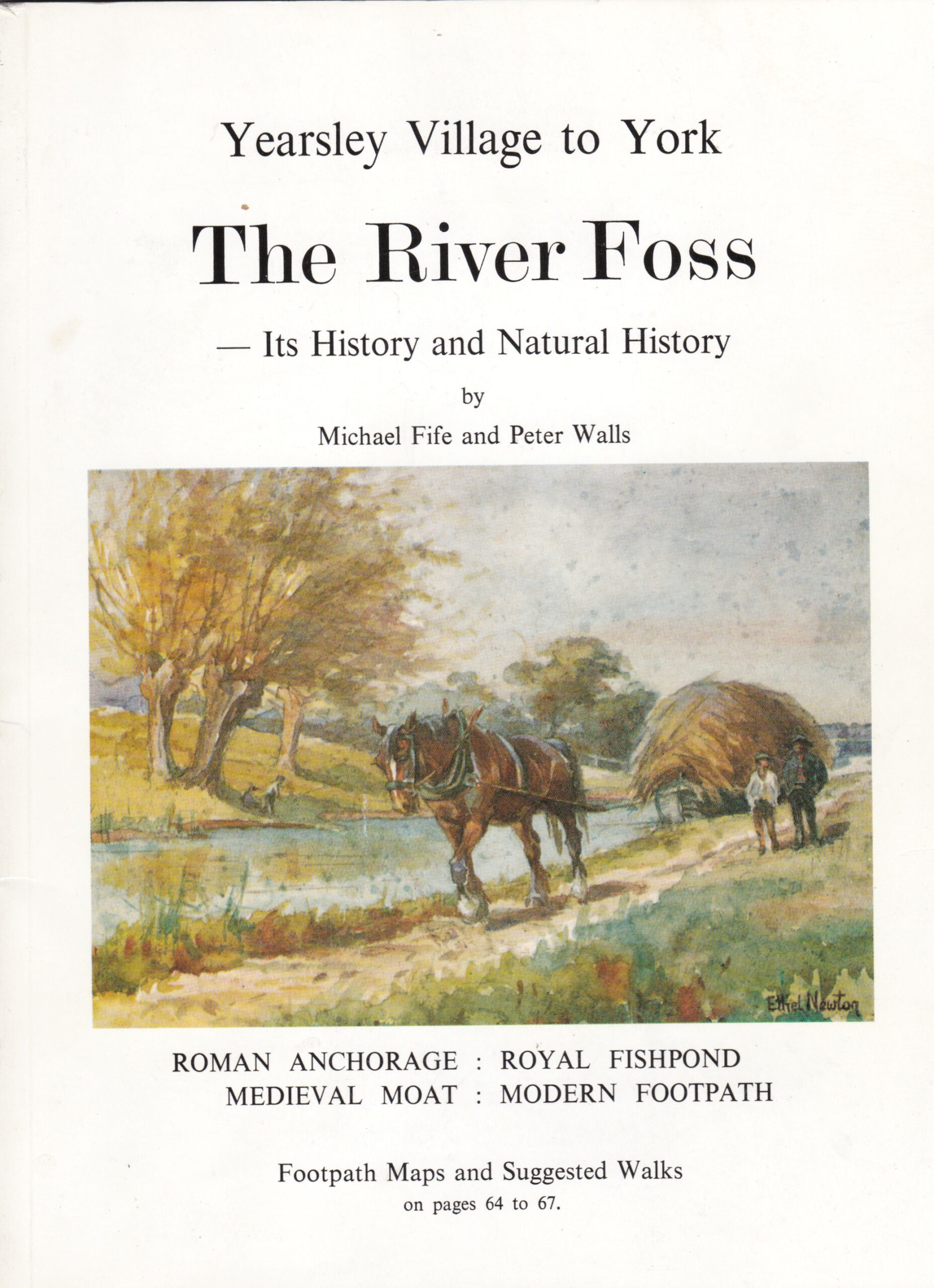
Figure 1: The front cover of The River Foss by Michael Fife and Peter Walls.
The Origins of the Society
In 1973, when William Sessions Ltd first published The River Foss, a loose sheet (Figure 2) was attached at the front of each copy reporting on the decision to establish the River Foss Amenity Society, both informing readers of the Society’s prospective formation and inviting them to join the Society at a fee of £1 (now £10) to be sent to the Society’s Honorary Treasurers, Barbara and Hugh Shaw, at Grey Willows, Huntington. The news of the Society was also advertised via a circular letter sent to all those whom Sessions thought may be interested. Thus, at 6:00pm on Monday 23rd July 1973, the New Earswick Folk Hall hosted thirty-five attendees at the Society’s inaugural open meeting.
The meeting commenced with a short introduction delivered by the Chairman of the New Earswick Village Association, Mr Kenneth B. Smith, who proposed that Bill Sessions should be elected the first Chairman of the River Foss Amenity Society. A Mr J.R. Ridges seconded the proposal and the other attendees agreed. Sessions assumed the position of Chairman before nominating Mr Hugh D. Shaw as Honorary Treasurer, which was seconded by a Mrs. Rowland, and the motion was thus adopted by the meeting. Chairman Sessions further nominated Mr Ian Goodwill as Honorary Secretary which was seconded by Mrs. E.M. Sessions and carried by the meeting.
Sessions began by welcoming attendees to the meeting before summarising his motivations for creating the Society, explaining that the primary objective of the River Foss Amenity Society was to “… Focus attention on practical ways of improving the footpaths and other amenities of the river for the benefit of naturalists, fishermen, ramblers, and local residents.”. The meeting – after some discussion and conversing about immediate and future plans – would later disperse, and thus began a Society that would strive to fulfil Sessions’ ambitions for the next fifty years and beyond.
More information about the history of the River Foss itself can be found on the website under “A Brief History of the River Foss.”
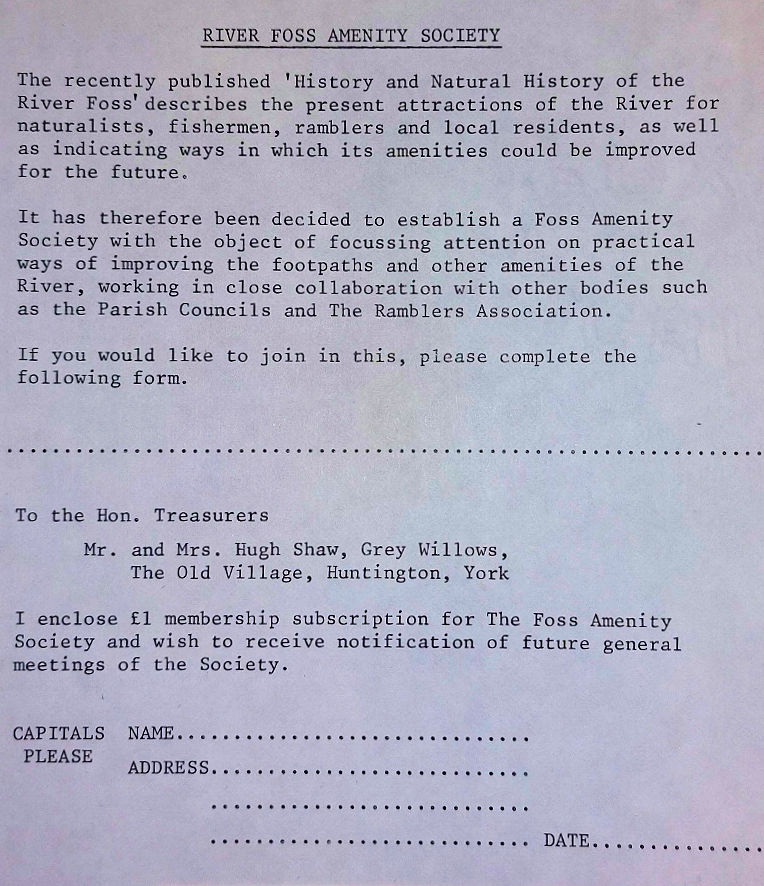
Figure 2: The 1973 note attached to copies of The River Foss Society inviting interested persons to join the Society.
The Yorkshire Foss-Way Path
Upon publication in 1973, copies of The River Foss were dispatched to officials at both Flaxton Rural District Council and the North Yorkshire County Council. In the following year, North Yorkshire Footpaths Officer Wilf (Bill) Boughey expressed his thanks for the publication and initiated the first of several meetings to express his vision of linking existing public footpaths along the Foss. Essentially, Bill Boughey saw the opportunity for and proposed the “Yorkshire Foss-Way” footpath which would see an approximately twenty-eight mile walking route from York’s city centre to the river’s source at Pond Head (then onward to nearby Coxwold village for “tea, rest and buses”) and vice versa. This would build on the work of David Nunns who, as Honorary Secretary of the Ramblers Association York Group, contributed to The River Foss book in 1973 with the segment “Suggested River Foss Walks” where he detailed several strolls surrounding the riverside. Nunns is one of the founding members of the Society and is still a member at the time of writing. While Bill Boughey was personally invested in the project of linking public footpaths, he was unable to make a formal proposition as he was a North Yorkshire civil servant; instead, he expressed his hope that the newly formed Amenity Society would make the proposition on his behalf with no official link to him. The Society obliged.
Bill Boughey agreed in January of 1975 that he would – from his own private residence – lead a small sub-committee of route-planners until, after producing a leaflet entitled ‘This is a Discussion Paper about a proposal for a Yorkshire Foss-Way Footpath from Pond Head near Coxwold to York’ (which slips off the tongue!), The Yorkshire Foss Walk had its official grand opening with an inaugural walk on Saturday 12th July 1975. Approximately one hundred individuals are reported to have partaken in the walk, beginning at Haley’s Terrace by the Cocoa Works and concluding upstream at the historic Lock Cottage at New Earswick. The walk was led by Lord Mayor Jack Birch and Sheriff Gerald Dean – both of whom delivered speeches and were joined by their Ladies wearing chains of office. Also in attendance was the Lord Mayor’s Butler, a policewoman, and a special constable. This group was accompanied by other notable individuals, including Colonel (was Major) John Nicholas Blashford-Snell – former British Army officer, explorer, and well-esteemed author – who had recently returned from an adventure along the Congo River of West Africa. If, like me, you would be interested to know how a short walk along the Foss compares to an expedition along one of Africa’s great rivers, we are indebted to the Yorkshire Post reporter for putting this very question to him, to which he answered, “Much more pleasant – I haven’t seen a hippopotamus all day!” The Colonel further added, “The more that’s done to encourage people to go out into the countryside the better. This footpath is a marvellous idea.”
And so, if any readers are tossing a coin over an expedition down the Congo River or the mighty Foss, we have it on good authority that the Foss is the more inviting of the two. Do, however, beware not of hippopotamuses, but of well-kept footpaths, bird song, and friendly dog walkers. I am further indebted to Mark Sessions for scanning and emailing the newspaper article from which this information was extracted, and for scanning the photographs below (Figures 3 & 4) from his late father’s collection.
As part of the celebrations for the Society’s fifty years of operation, around 30 members of the River Foss Society were joined once again by the current Lord Mayor (Councillor Chris Cullwick) and Sheriff of York (Sue Hunter) – and Bill Sessions’ sons Michael and Mark – to re-enact the inaugural walk, departing from Yearsley Baths and concluding upstream at the New Earswick Folk Hall where they enjoyed tea, cake, and conversation. The Chairman of the Society warmly welcomed the walkers – which included four walkers who were present at the inaugural walk, and the Lord Mayor congratulated the Society on fifty years of achievements.
It cannot be refuted that the opening of this pathway was a significant achievement, and so the Society continues to host an annual walk over a two-day span of 28.5 miles along the Foss. The “Foss Walk” is among the biggest and most anticipated events of the Society’s calendar, started by Mark Jones in the 1980s under the advice and assistance of North Yorkshire footpath officers and with encouragement from President Bill Sessions and then-Chairman Michael Fife. The creation of the Foss Walk was accompanied by an illustrated guide entitled “The Foss Walk” devised by Mark Jones (who is more commonly associated with his 1983 book A Walk around the Snickleways of York), featuring his hand-drawn maps and sketches. The guide, which was preceded by an earlier leaflet published by the Society costing 20 pence, was published for the River Foss Amenity Society by Maxiprint in 1988. The Society would then sell copies at £1.50 to those who wished to own a copy for themselves, and it was also made available in various local tourism offices – such as Easingwold Tourist Information. Unfortunately, the guide is no longer in production, but with thanks to Peter Hopwood, I have taken photographs (Figures 5, 6 & 7) of the leaflet and booklet to provide a taste of how the guides appeared. The Foss Walk today is primarily a leisure activity, but it serves the important practical purpose of surveying the condition of the footpaths so that they may be monitored, and their viability be upheld as a result. The full walk is undertaken annually over two days in June or July.
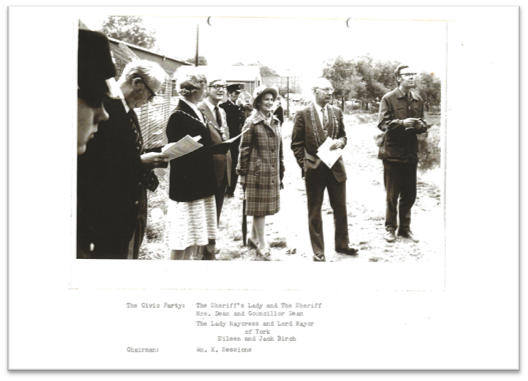
Figure 3: The inaugural 1975 walk. (River Foss Society Archives.)
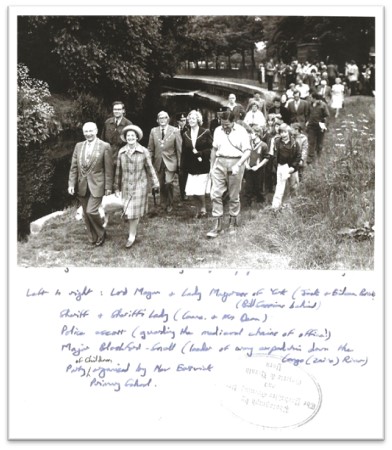
Figure 4: The inaugural Foss Walk. (River Foss Society Archives.)
The Foss Walk illustrated guide.
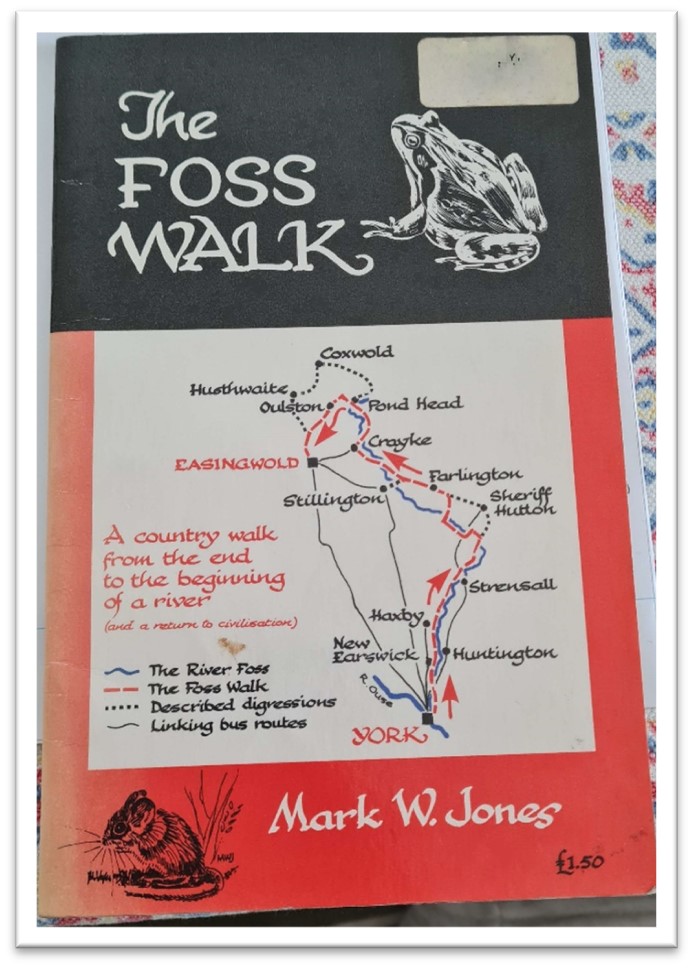
Figure 5: The front cover of Mark W Jones’ 1988′ The Foss Walk’ illustrated guide.
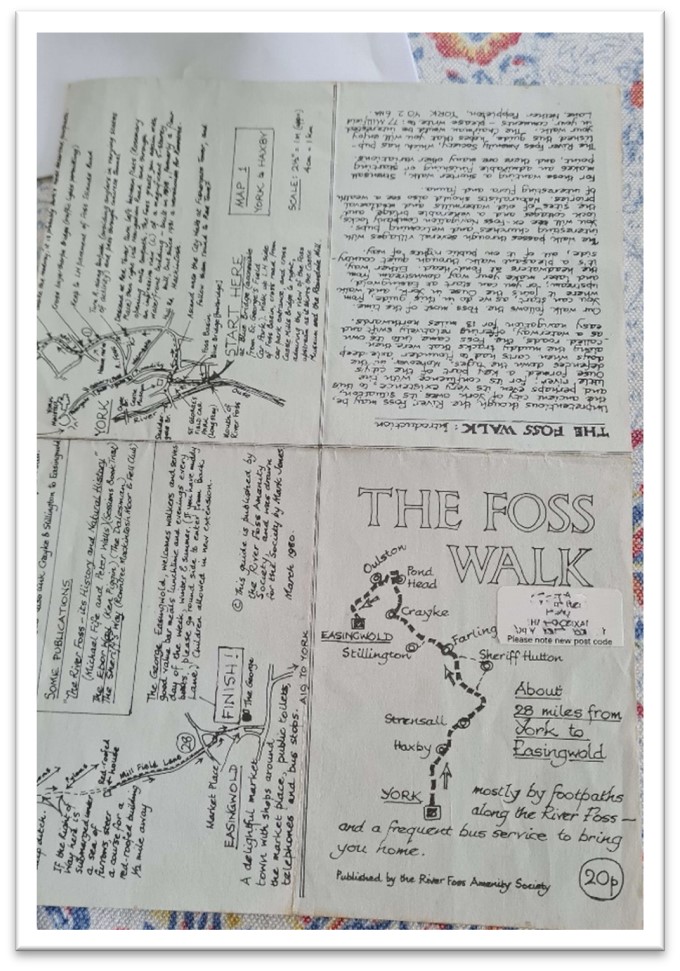
Figure 6: One page of the ‘Foss Walk’ leaflet published by the Society.
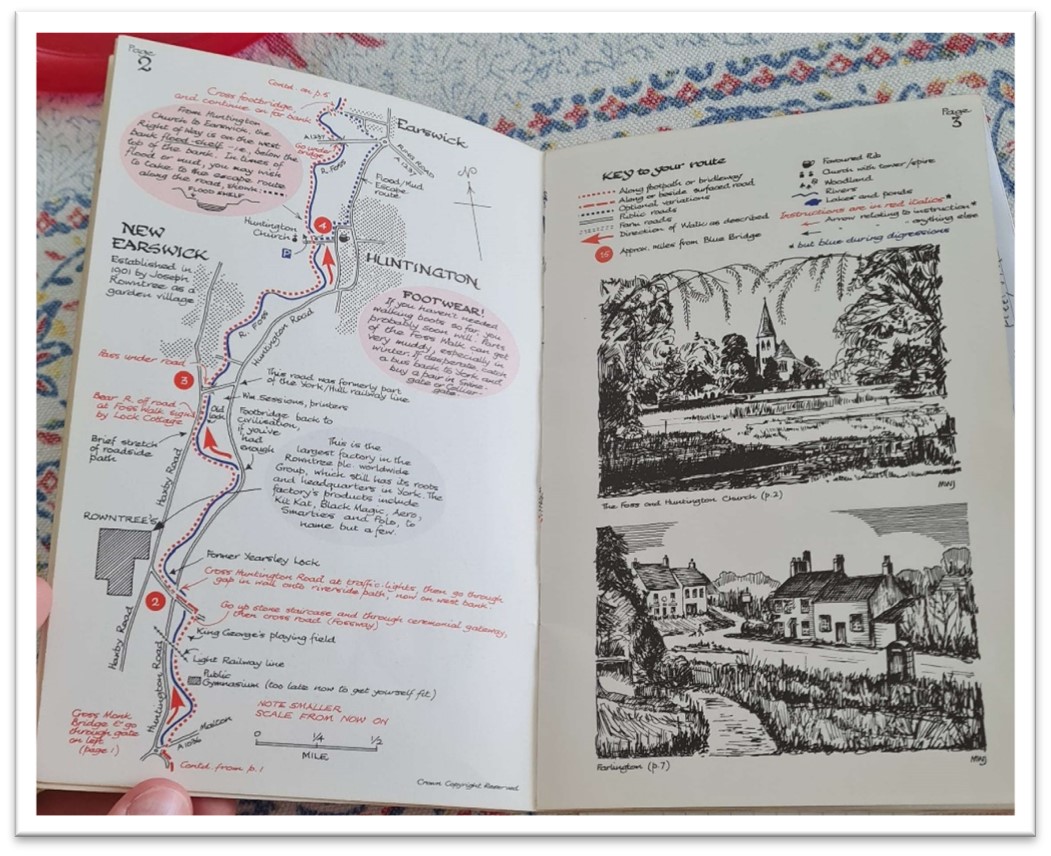
Figure 7: Inside page of Jones’ 1988 ‘The Foss Walk’ illustrated guide.
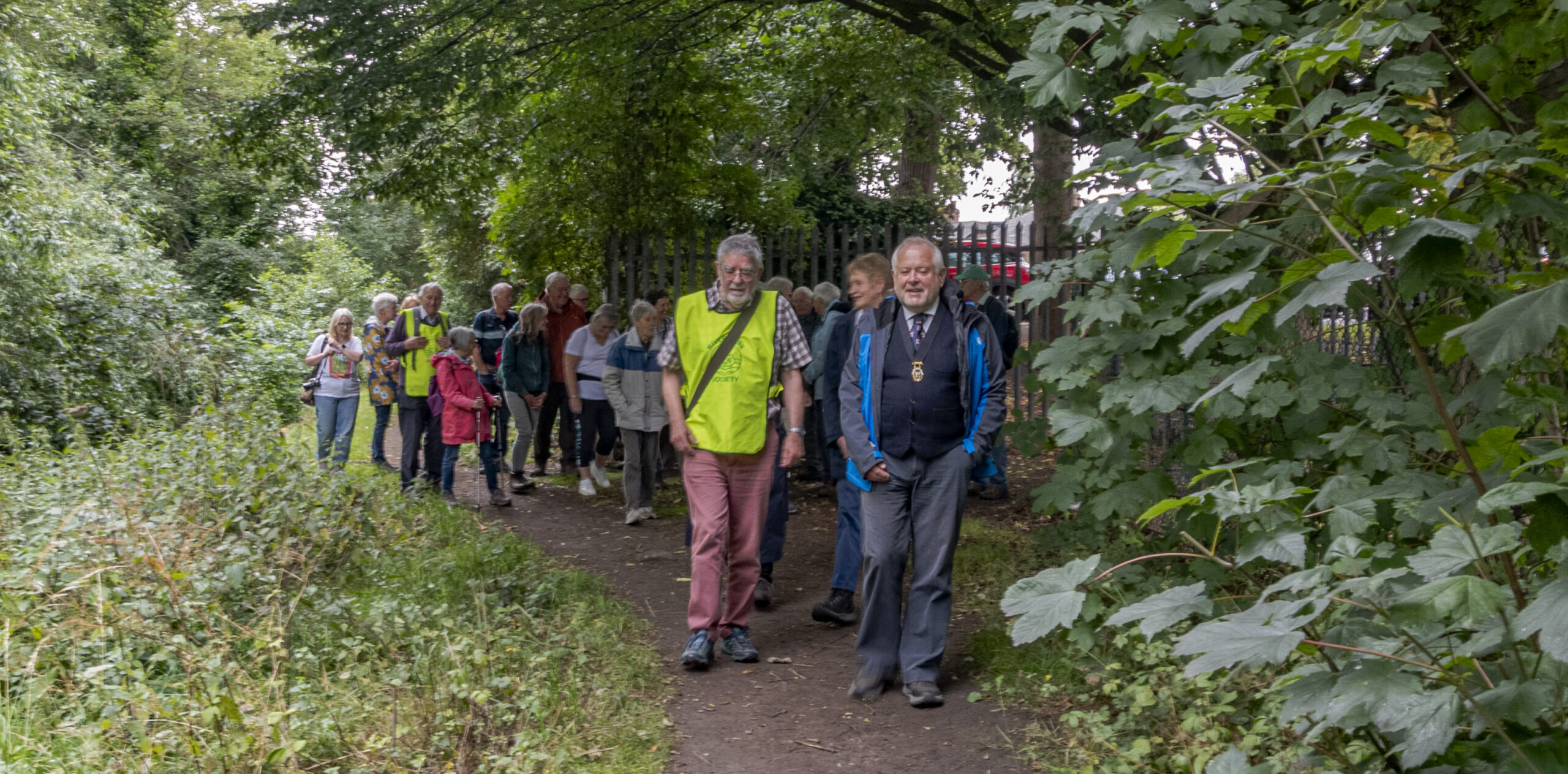
Figure 8: The River Foss Society 50th anniversary walk held to commemorate the inaugural event, 12th July 2023, (RFS archives)
Overcoming a Difficult Period
Though the Society had enjoyed much success throughout the 1970s and 1980s, it would enter a more turbulent period through the mid-1990s as long-standing and founding members of the Society would gradually retire – such as Bill Sessions (Founder, former-Chairman and President) retiring in 1995. While it is not possible to guarantee factual accuracy as much of the information is extracted from the living memory of long-standing members, the story of endurance and perseverance deserves to be shared nonetheless.
Membership numbers were maintained reasonably well throughout this period (and the newsletter was still produced regularly), but the primary concern for the River Foss Society was a declining number of committee members to run the operation. The Society found itself without a Chairman or Secretary for quite some time, and the issue was exacerbated when Rupert Ormond – naturalist and former Chairman who took on the role during this period – had to relocate to Scotland for work. Adrian Harrison would later become Chairman but attempts to rectify the situation by employing a paid Secretary proved unsuccessful as they lacked the required knowledge of the Foss. Subsequently, ceasing operation entirely became a real possibility to the point that the fate of the Society’s finances should the Society fold had been discussed by members of the committee.
Fortunately, dedicated existing committee members (which included, to name a few, the likes of Membership Secretary Peter Hopwood, Treasurer John Hampshire, and Pat Rattenbury who had moved from Essex to take charge of the Foss footpaths) continued to meet to ensure the Society remained active, with committee members themselves recording the minutes for the meetings. Pat Rattenbury would remain as the Society’s Footpaths Officer until his sudden passing in December 2009. A five-mile memorial walk was held in his honour, nicknamed “A Walk for Pat.”
John Hampshire had the idea of distributing as many as two thousand leaflets to residents living along the Foss, inviting them to two public meetings where they could learn about the Society. The leaflets were a resounding success, and around thirty people attended each meeting, which ultimately saw the committee double, memberships begin to rise, and the Society slowly regain its strength.
The situation would further improve when Carol Magson convinced John Millett to join the Society in 2004 before he was later invited to join the committee in 2005 by John Hampshire. Shortly after joining the committee, John Millett was asked to take over as Chairman from Adrian Harris because – by his own admission – nobody else was available, but the next thirteen-years of his leadership would prove to be a success. With a revitalised committee, a rejuvenated membership and a resolute Chairman, the only lingering question of ‘Secretary’ was to be solved by June Card volunteering her services of organising and coordinating events. After committee members had successfully kept the embers burning throughout a troublesome period in the Society’s history, June Card, and John Millett, among others, would play an instrumental role in reigniting the Society’s fire, restoring it to its former glory, and driving it forward into the modern day.
John Millett continues to serve the Society as Vice-Chairman to this day, and his contributions are still valued and appreciated by the committee and members. June Card is also responsible for the River Foss Archive in York Explore which took a considerable amount of effort to establish and is currently kept up to date by Membership Secretary Christine Gray. The archive is the first point of call for any individuals wishing to supplement their knowledge of the Society’s history or those who simply wish to view source material with their own eyes.
As the Society began thriving once more in the 2000s, it became necessary to adopt an official constitution. An AGM at 7pm on Friday 18th April 2008 would see the proposal of a constitution, and while some questioned whether this was necessary after more than thirty years without one, the Committee agreed to a constitution so the Society could take out Public Liability Insurance – for which a constitution is necessary.
Bridges and Stepping Stones
Upholding the practicality and quality of the Foss footpaths has proved to be a difficult task on numerous occasions, and the Society has expended much effort to ensure that the residents residing along the Foss can continue to enjoy recreational walks. This has proved especially challenging when public rights of way have become damaged or erased. Fortunately, in such situations, the Society has played an important role in pressuring relevant parties with the authority, resources, and responsibility to protect public rights of way – which, more often than not, is the City of York Council.
In the 2015 Boxing Day floods, the footbridge at Black Dike (located near Walbutt’s Farm, northeast of Strensall, grid reference SE 6483 6209, What3Words (rudder.farmed.rigs) was irreparably damaged by floodwater, forcing the Council to shut off access as passage over the footbridge had become unstable and unsafe. Despite plans to replace the footbridge as soon as possible, the Council’s footpath authority failed to resolve the issue until the River Foss Society pressed for swifter action, resulting in the Council eventually instructing York-based volunteer organisation The Conservation Volunteers (TCV) to rebuild the footbridge. Fourteen volunteers at TCV led by Bobbie Arnold manually lugged two beams weighing 550kg each to the remote location to support the bridge’s walkway. The beams were secured to a concrete foundation and the all-timber footbridge was completed at approximately 9 metres in length and 1.22 metres in width. The Society received news from City of York Council Public Rights of Way Officer Richard Hoyland that the footbridge had been completed and the footpath had been opened once more.
Black Dike is a channel that feeds the Foss which itself is fed by The Sike – one of the primary surface water drainage channels for Strensall Common. The footbridge itself is significant for not only being a well-trodden path for locals but also for carrying both the Foss Footpath and Centenary Way national footpath northwards to Sheriff Hutton and beyond. Furthermore, it would take around forty minutes to walk to the nearest river crossing at Strensall Bridge. TCV have made a commendable effort to reinstate the bridge, and the Society can proudly hold its head up high having applied necessary pressure to City of York Council, once again preserving the recreational viability of Foss footpaths.
Unfortunately, the reinstatement of a public right of way is not always a straightforward endeavour. Indeed, attempts to re-establish paths that have fallen victim to harsh weather conditions have often been rather frustrating, as evidenced by attempts to replace the footbridge crossing the Foss at Cowslip Hill, Strensall, after the original footbridge was lost to flooding in the early 1950s. The Society has been in discussion with the City of York Council footpath authority since the year 2000 in an effort to replace the footbridge, yet over the course of twenty-three years, no bridge is yet to be constructed.
There are several reasons for the lack of progress (or indeed the lack of bridge). Minutes from a Strensall with Towthorpe Parish Council meeting from 13th April 2021 indicate that progress has primarily been stunted due to issues of accessibility. Accessing the river from the public right of way on the northern side is reported to be a challenge due to a steep drop from Sheriff Hutton Road and the landowner’s opposition to accessing their land; as no bridge currently exists, there are no statutory powers to enter the land. Indeed, the dominant factor in the lack of progress is the landowner denying any knowledge of the bridge’s existence and refusing to allow contractors onto the land. It appears that the only access to the river must come from the southern side, but this would still be challenging due to the remoteness of the location. The final major factor for the bridge having never been reinstated is the matter of funding, with the minutes suggesting that the reinstatement of the footbridge is competing against other high-importance and high-cost issues relating to public rights of way that require more urgent attention. For example, it may be necessary to prioritise issues such as bank collapses which present a threat to members of the public using riverside paths.
The minutes also ponder whether they may use the footbridge at Leeman Road after redeveloping the area surrounding the National Railway Museum and must decide whether reusing the bridge would make both practical and financial sense, or whether building an entirely new footbridge would be preferred. Regardless, no footbridge currently exists at Cowslip Hill despite the Society’s efforts to engage in conversations with the City of York Council. It would appear there are many issues to work through before a new footbridge at Cowslip Hill will be installed – most of which would extend beyond the Society’s power. It can only be hoped that a breakthrough will be achieved in the near future, at which point I am certain the Society will be involved in some form – whether that be in discussion, consultation, or other.
Another unsuccessful attempt to reinstate lost pathways is evidenced by the Society’s attempts to have the stepping stones that once crossed the river at the bottom of Mill Hill, Huntington, put back. Much of the information about the stepping stones stems from three sources: The River Foss book by Michael Fife and Peter Walls; Geoffrey Freer’s private collection (with thanks to his son, Peter Freer, for sending me an extract his late father wrote about the stepping stones); and letters addressed to the Society. Some of the information contradicts occasionally (mostly regarding exact dates) but the story is unaffected. When dealing with the more obscure aspects of local history, we often must accept a degree of ambiguity.
To provide a brief history, the stepping stones were placed opposite 580 Huntington Road – where there was a dip in the east bank of the river to allow animals watering access – between approximately 1914-1917 when the weir at New Earswick was demolished by German prisoners-of-war and the river became shallow enough upstream to have stepping stones installed. Jim Ward of Manor House told Geoffrey Freer in the 1950s that he and other local village men placed the stones around 1914. The stepping stones would then be replaced in the 1930s by three large concrete blocks at the instigation of Huntington Parish Council. Mr Magson was then Chairman of the Parish Council and he, alongside ‘Ley’ (both being members of the Working Men’s Club), produced and cast the blocks, and their initials were carved into two of them. The stepping stones served the local community by providing a shortcut between the villages of Huntington and New Earswick; the shortcut was especially important for New Earswick residents because, it being a Quaker village, there were (are) no public houses as there could be no licences to sell or serve alcohol. So, for numerous years, residents of New Earswick would use the stepping stones to shave valuable minutes from their commute to the Working Men’s Club in Huntington. The thought of those same residents then attempting to cross the stepping stones back home after a few well-earned pints is both amusing and terrifying.
The concrete slabs remained in the river, undisturbed, for the next thirty years – even when Italian prisoners-of-war dredged the river in the 1940s – until the Internal Drainage Board removed the stones several times during the 1960s to improve the flow of the river as branches would catch on the stones and cause other debris to clog. After all, the Foss’s primary role was (and, as well as serving as a local amenity, still is) drainage – of upstream farmland especially. If, like me, you were wondering how and why the stones were removed several times throughout the 1960s, the answer is that some unknown (presumably local) Samaritan(s) placed the stepping stones back in their original position, much to the frustration of the IDB who then had them removed numerous times in an almost cartoonish back and forth. In response to the repeated mysterious reappearing, W.E. Lockwood, Parish Council Chairman (Huntington or New Earswick – I am not certain), made the statement, “I do know how this happened, but I can’t tell you – it’s one of those sort of things,” which, while unhelpful to our understanding of the situation, does make for a rather amusing anecdote.
In 1971-1972, however, the IDB fully enacted their River Improvement Scheme which saw, among other modifications, the clearing of the riverbed between the York’s city boundary and Goland Dike before Towthorpe Bridge to improve river flow, as well as the widening of the river from 30ft to 40ft as per flood relief efforts, creating a shelf-like bank in place of the towpath. The IDB removed the stepping stones once and for all and they would never make a return. On a sidenote, the IDB also demolished Dowker’s Swing Bridge (c. 1800, named after Captain Dowker who owned the manor house West Huntington Hall at the time) which spanned the river opposite 575 Huntington Road, as well as the picturesque bridge that crossed the drainage ditch once running alongside the Foss. I for one believe that losing the stepping stones and two bridges is a tragic event in the area’s local history, and I would like to believe that modern regulations would not allow us to lose pieces of our history so easily, and that the Society would have sternly intervened had it been formed just a few years sooner. Traces of the bridges can still be seen today, and I would recommend the section on the River Foss Society’s website “The Archaeology of The Foss Navigation – Huntington Ings and Earswick Landing – Tony Berry” for further information. Tony Berry has created numerous expertly-crafted resources for the River Foss Society, using his talent and knowledge to manufacture readable, yet educational, illustrations detailing the history of the Foss – especially its canalisation.
After the stepping stones had been removed for good, a quarrel between the IDB and Huntington Parish Council ensued, with the Parish Council demanding they be reinstated and the IDB insisting they were an obstruction to river flow. In a compromise, Huntington Parish Council requested that the stones be returned to their possession and the IDB finally agreed, but warned the Parish Council that the stones must not be placed by the river (so that they did not find their way back in) and that they would not tolerate the stones being replaced. Though New Earswick Parish Council and Huntington Parish Council both pursued an interest in having the stones reinstated, which included seeking advice from the North Riding County Council, according to Geoffrey Freer writing in 2011: “With [the] politicisation of the council at the following elections the matter fell into abeyance so far as the council were concerned,” and he further added: “After some discussion I agreed to their being stored on an unused patch of my garden near to the road where they could easily be accessed in the future if some agreement to their replacement was reached or, alternatively and unofficially, some public-spirited person(s) with a JCB might take it into their head to put them back where they belonged when nobody was around to say nay.”. The stones still rest there today, but following the passing of Geoffrey Freer, his son (Peter) plans to sell the house, and so the fate of the stepping stones is once again unknown. I personally feel it would be a great shame to lose sight of them because they would be near impossible to find again. Being a relatively small Society, however, it might not be possible to rehome them as they are rather substantial solid concrete blocks and would require the use of heavy-lifting machinery. It is my personal belief that they should rest in a secluded spot along the river where local wildlife can make good use of them as a habitat.
It would appear, then, that Huntington Parish Council had forgotten about the matter after changes in leadership. The River Foss Society, however, soon became involved and would argue that, after twenty years of continuous public use, the stepping stones constituted a public right of way. Thus, evidence forms of the public’s use of the stones was collected, and Bill Sessions made Bill Boughey aware of this in 1975. A Peter Harrison, for example, lived at Huntington Hall Farm in the 1930s and stated that his family accepted there was indeed a Public Right of Way across the river via the stepping stones. Frustratingly, the stepping stones were never included in the definitive map of the Foss Walk, but residents of both parishes agreed that they ought to have been.
The Society continued its pursuit to reinstate the stepping stones throughout the 1980s and sought advice from the Ramblers’ Association. In 1992, however, the quest to reinstate the right of way across the river where the stepping stones sat was abruptly halted by a letter from Huntington Parish Council stating that they did not wish for the stones to return on account of them leading to a bend on what had become a busy main road with no footpath on that side of the river which would put the public (children especially) in danger. It was also felt that the stepping stones would be a danger (again, especially to children) when the river becomes swollen in heavy rain. In a regrettable twist, the very same Parish Council that once campaigned for the stones’ reinstatement would, two decades later, appear to prevent the Society from doing just that. The Society must accept that, while they can mobilise campaigns and bring issues to the attention of the authorities that can take further action, they are limited in how far they can enact ‘actual’ change themselves. As a resident of Huntington living within just two hundred metres of where the stones once crossed the river, member of the River Foss Society, and local history enthusiast, I strongly feel that the stepping stones should either be reinstated as an amenity for local residents, or, perhaps more reasonably, there should be some form of river crossing where the right of way clearly once stood. I am sure that most members of the Society would agree, but without the backing of any real authority, it would be virtually impossible and will most likely never come to fruition.
In subsequent years, the water-stead (that being the stooped section of land that once gave watering access to animals and later to the stepping stones) has been filled in with spoil from the skimming and resurfacing of Huntington Road. Since the 1992 letter from Huntington Parish Council, however, the verge has been cut back by City of York Council and a segregated cycle-path created, making any form of river crossing far safer to pedestrians. According to Geoffrey Freer, the stretch of land between 575 Huntington Road and the pumping station is ownerless and could be registered as a village green in order to preserve its potential use for the future. It feels unlikely, however, that a river crossing will ever exist at this spot again and we may have to resign ourselves to this particular part of our local history being little more than a memory. An agreement over who should fund the river crossing is but the first of many hindrances to soon return us reluctantly back to reality. That is, of course, unless the River Foss Society renewed its interest.
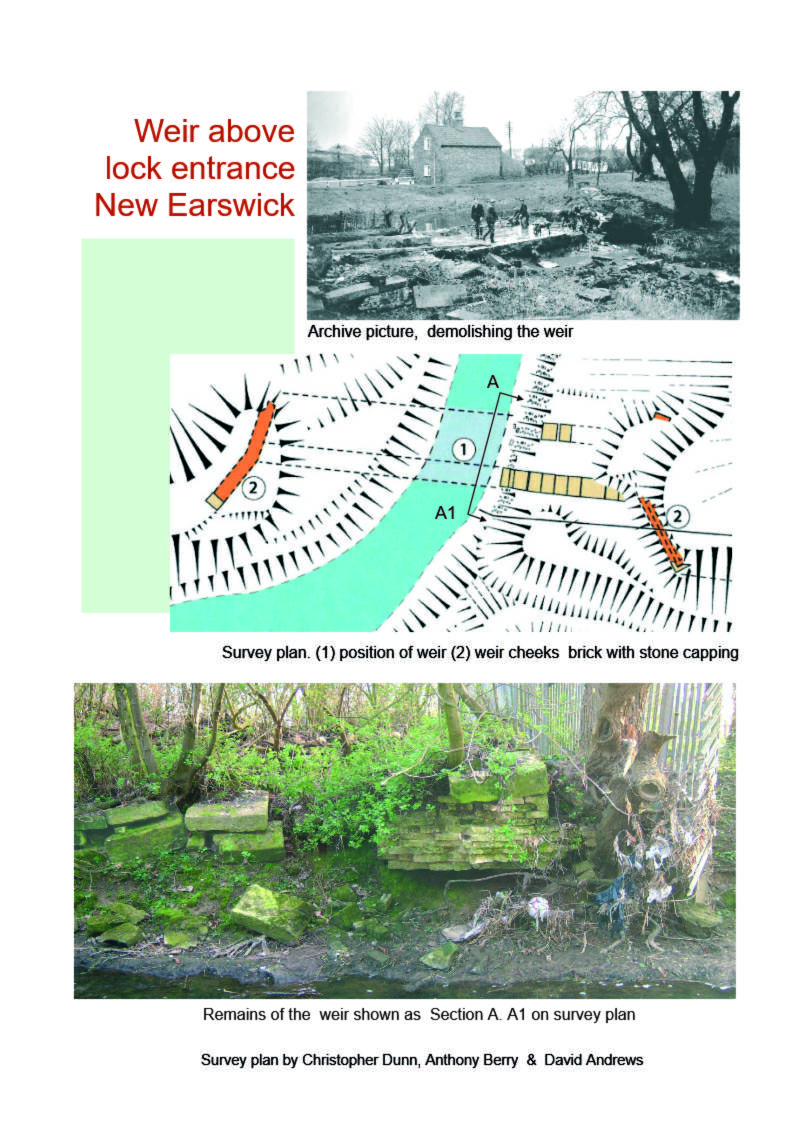
Figure 9: The demolition of the weir at New Earswick (which lowered the river level), and some additional information about the weir.
By Tony Berry (see the Foss History page for this and other slides on the Archaeology of the River Foss).
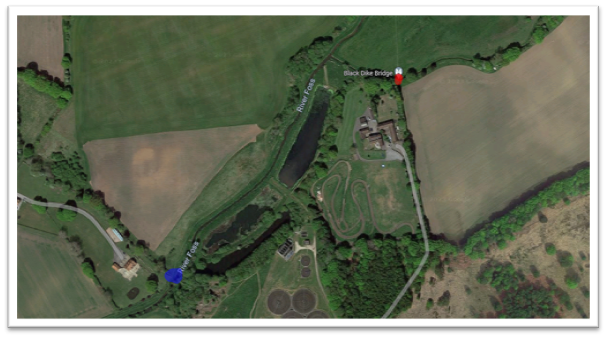
Figure 10: The two bridges mentioned in the above. Marked in red is the site of Black Dike Bridge, and in blue is the approximate site of the missing bridge at Cowslip Hill. (Screenshot from Google Maps).
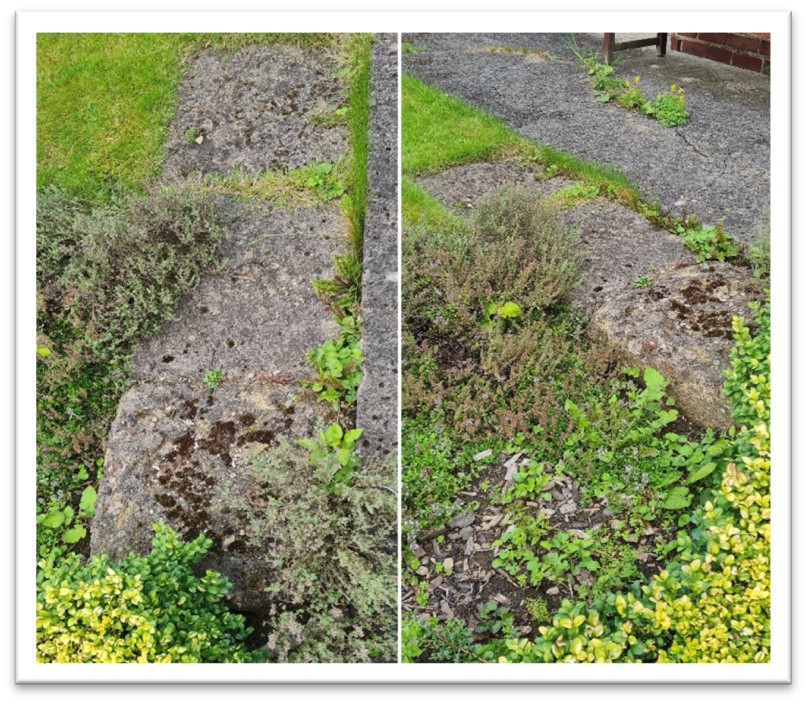
Figure 11: Three large concrete blocks that once were stepping stones, located now in the residence of the late Geoffrey Freer. (Many thanks to Peter Freer for allowing me to take these photographs for the project.)
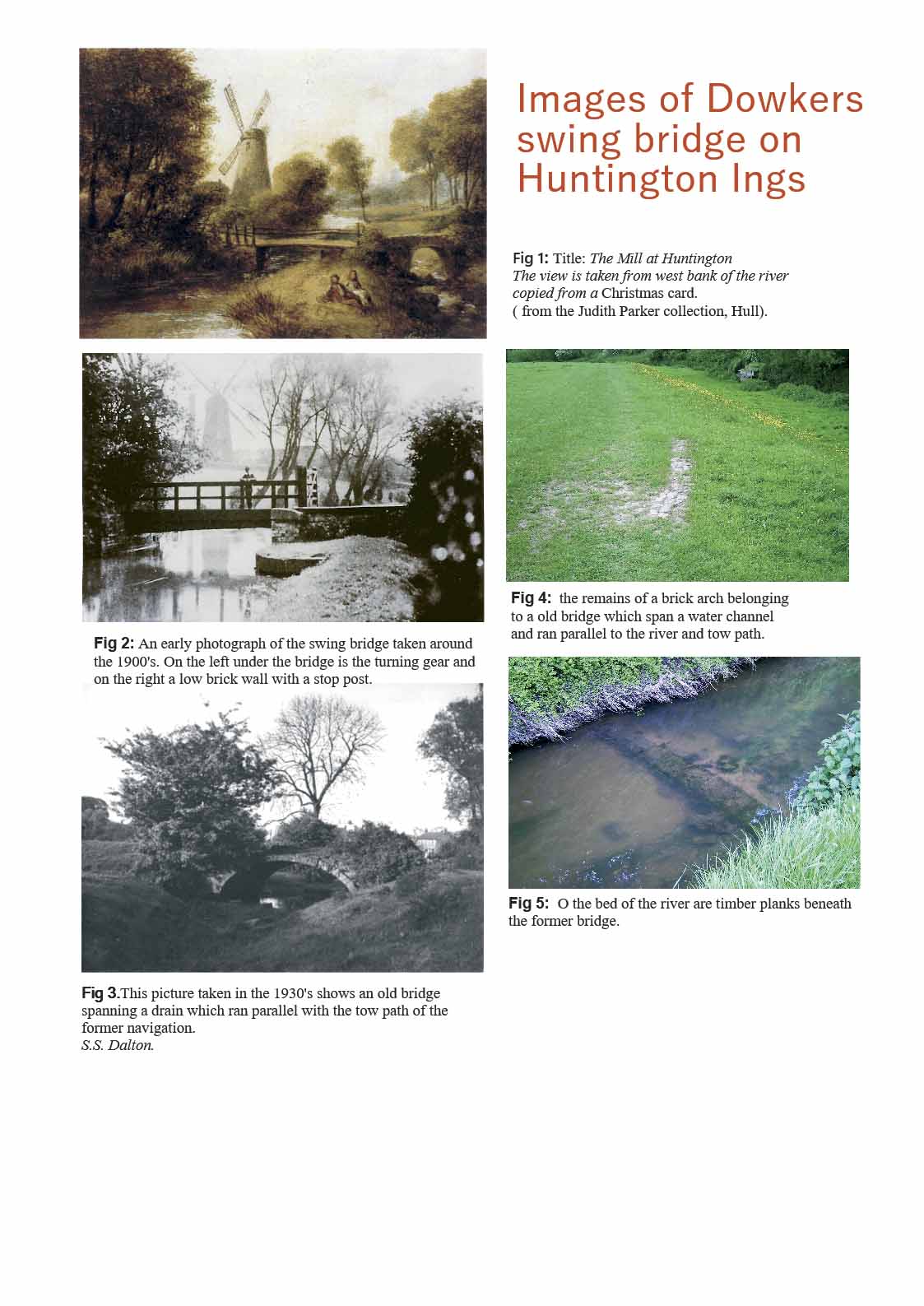
Figure 12: A copy from Tony Berry’s work on the River Foss Society website, illustrating the history of Huntington Ings. .
See the Foss History page for this and other slides on the Archaeology of the River Foss.
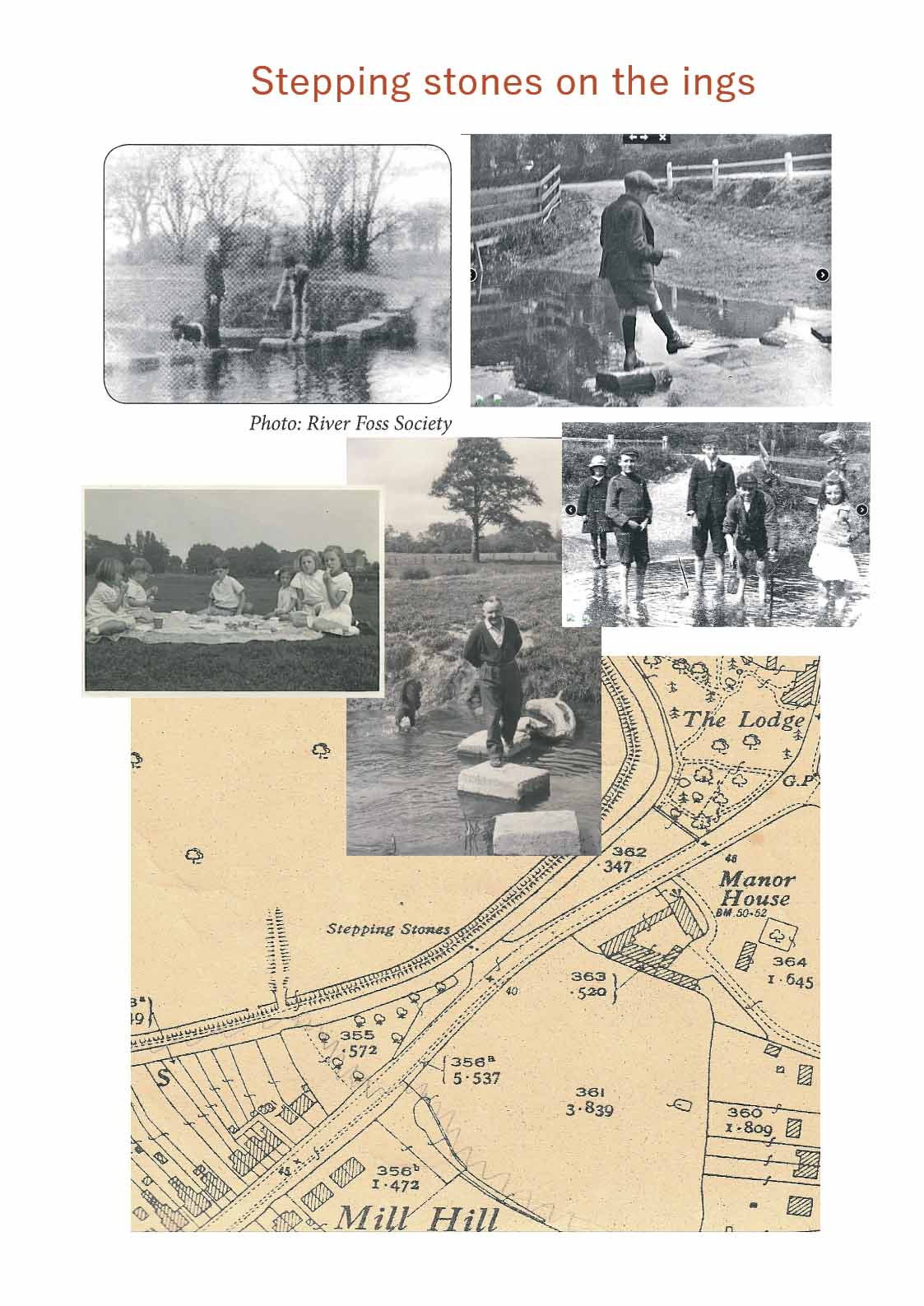
Figure 13: Photographs from Tony Berry’s work on the River Foss Society website, showing the stepping stones crossing the river at the foot of Mill Hill. Note the children playing and the local man (possibly Jim Ward of Manor House) walking his dog.
See the Foss History page for this and other slides on the Archaeology of the River Foss.
Contributing to the River Foss and its Natural Habitats
Considering Bill Sessions’ passion for nature as a naturalist, and understanding that the Society strives to improve the biodiversity of the River Foss and to preserve its natural habitat, it would come as little surprise to know that a significant portion of the River Foss Society’s time and resources has been, and still is, dedicated to upholding the sanctity of the river’s natural world. This includes regular litter-picking sessions held by the Society, which often sees members take to the waters on the City of York Council barge, Foxy, to retrieve litter from the river. The Society also hosts or attends lectures from experts in biodiversity (aided by close proximity to two York-based science research sites and two universities), and many members themselves are remarkably knowledgeable about the river’s natural world. The Society has often also tended a stall with the local branch of the Inland Waterways Association at the highly anticipated annual Dragon Boat Challenge on the River Ouse in York’s city centre hosted by York Rotary as part of the yearly Festival of Rivers, and have manned many other stalls at various events, such as the York Walls Festival. These stalls have proved a successful method of raising awareness for the river’s natural world and have been a particular favourite among children throughout the years who appear to be highly engaged in protecting the river’s living creatures. Hosting a stall at the 2010 Dragon Boat Race proved to be challenging, as it was noted the gazebo almost toppled over in strong winds, but the Lord Mayor and Sheriff of York seemed to enjoy their visit, nonetheless. It is difficult to write in detail about litter-picking, stalls and talks as they occur with such frequency, but the Society website hosts archived newsletters spanning from Autumn 2007 which detail the Society’s activities to help the river’s wildlife, and so if one wishes to learn more about the ‘common’ efforts for the natural world that the Society contributes, one should consider perusing the archives.
As many will know, the Foss has been a rather mistreated stretch of water and has been victim to countless human abuses over the course of the last millennia or so, causing significant harm to the river’s habitats. It is easy to forget that significant events, such as the 11th century damming of the Foss at its confluence with the Ouse to create a moat, the deforestation of the Forest of Galtres which once extended from the Foss’s source to York’s city walls, and the canalisation of the Foss, have, among other major historic human interventions, all contributed to the loss of biodiversity along the Foss. In more recent years, the Foss’s natural world is especially plagued by a rampant mink epidemic, invasive plant species, and by sewage treatment facilities situated on the Foss’s riverbanks.
Invasive Species
According to the Canal & River Trust, American mink first arrived in Britain in 1929 for the purpose of fur farming and were first reported to be breeding in the UK in 1956. Mink have become a significant problem for UK waterways after, over the course of several decades, they have gradually escaped from farms or been released by animal rights activists without understanding their detrimental impact on the environment. American mink are adaptable, invasive, highly-skilled hunters with a broad diet of birds, fish, amphibians and small mammals and, with no natural predators in the UK, their populations have grown without governance. One particular concern for the River Foss is that mink prey on water voles, which are a protected and declining species in the UK, and have contributed to the decline of the species in the local area. Indeed, a mink was caught recently roaming around my own garden that backs onto the river, slaughtering the neighbour’s chickens after digging under the mesh wire. The River Foss Society is limited in how they may approach the issue of mink as they are highly elusive creatures, but they have been placing humane mink-traps along the river, albeit with fairly limited success. The Society also makes efforts to encourage water vole life in the river, but as mink will infiltrate their burrows, this has proven almost impossible. Members of the Society have recorded vole activity by placing small wooden boards attached to a rope on the river with the idea that water voles, being curious creatures, will climb the boards and leave droppings and thus the Society will know if there are water voles in the area. Recent recordings, however, have shown no sign of vole. I personally assisted Bill Twist in retrieving the boards in this summer’s set of recordings. The boards had been subject to some turbulent river flow due to significant rain in July, but there were still no droppings to be counted, and signs of water vole activity are becoming few and far between. One final strategy for moving mink is to encourage otter to take control of the river as they are territorial animals, but this has its own set of challenges.
To help alleviate the presence of invasive plant species, the Society hosts annual Himalayan balsam-pulling sessions. An invasive plant species introduced to the UK in the 1830s as a garden plant for its vibrant pink or purple flowers, Himalayan balsam (Impatiens glandulifera) soon began to naturalise in the wild, growing rapidly along waterways and riverbanks where it uses water flow to disperse its seeds. As such, Himalayan balsam is particularly suited for riparian environments – such as the Foss. Himalayan balsam is known for its ability to grow rapidly and out-compete native plant species, growing up to three metres tall and producing a great number of seeds which explode from the seed pods, enabling them to colonise areas with haste and, because they form dense thickets in areas they occupy, hinder biodiversity in the areas they colonise. Furthermore, Himalayan balsam is an annual plant, dying back and leaving no roots to stabilise the banks, making them vulnerable to erosion. Nettles in contrast are perennials and their root structure reinforces the banks. All of these characteristics are, of course, detrimental to any riverside. As a result, the Society regularly mobilises its members to pull balsam from the riverbanks in the summertime, but because of the sheer vastness of the issue, it sometimes feels like an uphill struggle. Fortunately, the shallowness of the root system means they can be plucked from the ground with relative ease, and the feeling of removing a gigantic Himalayan balsam plant in one calculated action is rather satisfying. In particularly wet summers, the Society has found it difficult to run balsam operations as the riverbanks become slippery and dangerous, and the experience would become generally unpleasant. July 2023 has been just one example, but the window of opportunity to bash the balsam is limited as the seeds begin to ripen in late summer and explode at a touch. Furthermore, just when the Society believes they have reclaimed a patch of land, the balsam may well make an unwelcome reappearance as seeds can stay dormant underground for as many as four years. Despite the challenges, if left unchecked, the issue would only increase.
The Society also works with the relevant authorities to uphold adequate water quality, but due to sewage treatment works situated on the banks of the river, it frequently experiences significant declines in water quality which have occasionally led to local fish extinction events in the Foss. Again, the sheer volume of these can be found in the archived newsletters, and it may shock many to see just how common such events have been and still are. Just this summer (2023), for instance, hundreds of fish were spotted dead in the river, which the Environment Agency attributed to low oxygen levels in the water due to the high temperatures and low atmospheric pressure. Despite Yorkshire Water claiming there was no sewage found present in the river, University of York scientists performed water quality tests and found that raw sewage is likely to be a factor in the death event, and the Society concurs. Talking to York Press, Dr John Wilkinson from the Department of Environment and Geography explained that there was “undeniable” evidence of raw sewage in the river at the time, stating: “The most clear-cut evidence of a sewage overflow on June 20 are the concentrations of paracetamol in the river.”. He added: “Paracetamol is a good indicator of untreated sewage as wastewater treatment plants are very effective at removing it from sewage. Hence, a high concentration of paracetamol in a river is a strong indication that untreated sewage is likely present.”.
The Society conduct their own water quality tests using a chemical analysis of phosphates and nitrates to detect pollution and examining macro invertebrates living on the riverbed as an indicator of the river’s health over extended periods. Again, the Society is limited in how much power it possesses to enact change themselves, but continued pressure and holding sewage companies accountable contribute to keeping the river as healthy as possible, endeavouring to aid the Foss as a thriving ecological hub for a diverse array of wildlife.
Over the course of fifty years, the Society has become acquainted and worked closely with a great number of organisations, from the Internal Drainage Board and City of York Council to the Inland Waterways Association. Two like-minded groups that the Society have begun working closely with for the benefit of the river’s ecosystem are the charity of St Nicks, who describe themselves as “The Green Heart of York”, and New Earswick-based conservation group Community Action for Nature (or CAN) who wish to encourage residents of Joseph Rowntree Housing Trust in uniting for the benefit of encouraging nature to flock to a small but beautifully maintained stretch of riverside. In the last few years, the River Foss Society and CAN have collaborated on several occasions, including balsam-pulling and for several bat-walks using bat detector equipment to measure their activity along the river in the New Earswick area, and the interactions between the Society and CAN have so far proved to be exciting and fruitful. This is little surprise as core values align, and many members of the Society are also members of CAN. Indeed, one of the founders of CAN, Will Durrant, is also a River Foss Society member.
The Society has collaborated with St Nicks on several environmental projects, and among these is the exciting ongoing project of “Green Corridors York” which is a St Nicks-led initiative to expand and link all the existing or lost green spaces in York to increase biodiversity, allowing greater mobility for species to expand or to relocate when disturbed by human action. The natural environment the Foss fosters is, of course, a key part of this project, and the River Foss Society are therefore assisting St Nicks in their ambitious project. More about the project can be found on the St Nicks website and on the River Foss Society website.
Nature Reserves
The Society has a long existing history of aiding and assisting nature reserves – little surprise when considering Bill Sessions’ devotion to the natural world. Bill Sessions was responsible for establishing the private Sessions Nature Reserve in 1967 and was himself Chairman of the New Earswick Nature Reserve for more than 45 years. The River Foss Society had a significant role in the curation of the Foss Island Nature Reserve in York’s city centre – a lesser-known reserve as it is not open to the public. The Foss Island Nature Reserve is situated on the site of the cooling tower at the former Foss Island power Station – often referred to as York Power Station. Built by York Corporation in the 1890s and opened in February of 1900, the small coal-fired power station generated electricity for the city of York, until it was closed on 25th October 1976. The buildings were later demolished around 1980 and discussion took place regarding what should be done with the area. Three members of the River Foss Amenity Society – John Nursey, Bill Sessions, and Mark Jones – proposed that this patch of disused land adjoining the river should be made a nature reserve, and City of York Council agreed and curated the reserve. Dave Houldershaw was the committee member responsible for the site for many years. Bill Sessions introduced a pair of nesting swans to the new reserve, and while their stay was fleeting, swans, herons, kingfishers, and other bird species have been spotted on the reserve in the following decades. City of York Council would later hand ownership of the reserve to the Hungate Developers.
Due to the reserve’s location as an appendage to the Foss, flooding is frequent, meaning access to the public has not been possible as installing footpaths is not feasible. Uncontrolled bushes and brambles only add to its inaccessibility, but, on occasion, visits are made to the site. On the 18th of August 2010, for example, twenty-seven members of the Society were led by the Environmental Consultant, David Houldershaw, who explained the environmental work done to the site and how they protect wildlife, such as building an otter holt to provide complete darkness and a birthing area. He further explained how otter spraint (dung) is used to encourage otters to locate to the area as they are highly territorial.
The Society has further contributed to the Foss’s natural environment by planting trees. Trees are, of course, an essential part of nature, and it was hoped that planting trees within close proximity to each other would enable birds to commute between them and provide ample habitat. Trees also improve the appearance of the river, making the area look greener and fresher for those who enjoy spending time along the Foss. Among numerous other locations along the river, the Society has planted trees near the Tannery site in Strensall (planted by former Honorary Secretary Shirley Jones in memory of her late husband) and, despite the structure being demolished and replaced with housing, the trees still exist along the towpath. The Society also planted a mixed hedgerow of hazel, hawthorn, and alder tree to hide the tall wire fence belonging to a sports field backing onto the Foss in Strensall. Other contributions include various species of trees planted on the riverside of Groves Playing Field, York, and the park at Earswick. Additionally, a rare poplar tree was planted at Foss Island Nature Reserve.
In 1983, the Society decided to celebrate its tenth anniversary in two ways. The first was to conduct a Special Celebratory Walk from Huntington to Strensall, beginning in Huntington at 10:30am on Sunday 17th July and arriving in Strensall in time for celebrations at the Ship Inn, and the second was to plant ten trees the following autumn near the Foss as a permanent exhibition of the Society’s continued interest in the river’s wellbeing, as well as beautifying its appearance. The Society would further push the 1983 tree-planting initiative by encouraging every member with a garden near the river to consider planting a tree in that year, or to perhaps obtain permission to plant a tree in an area close to the river if their own garden was not suitable.
It is worth noting that the Society encourages members and non-members to ‘adopt’ a section of the river that they walk regularly, to note any untoward sightings so that they may be added to a database, and to report serious incidents to the Environment Agency. The Society also encourages river monitors to maintain the natural environment and presentation of the riverbanks.
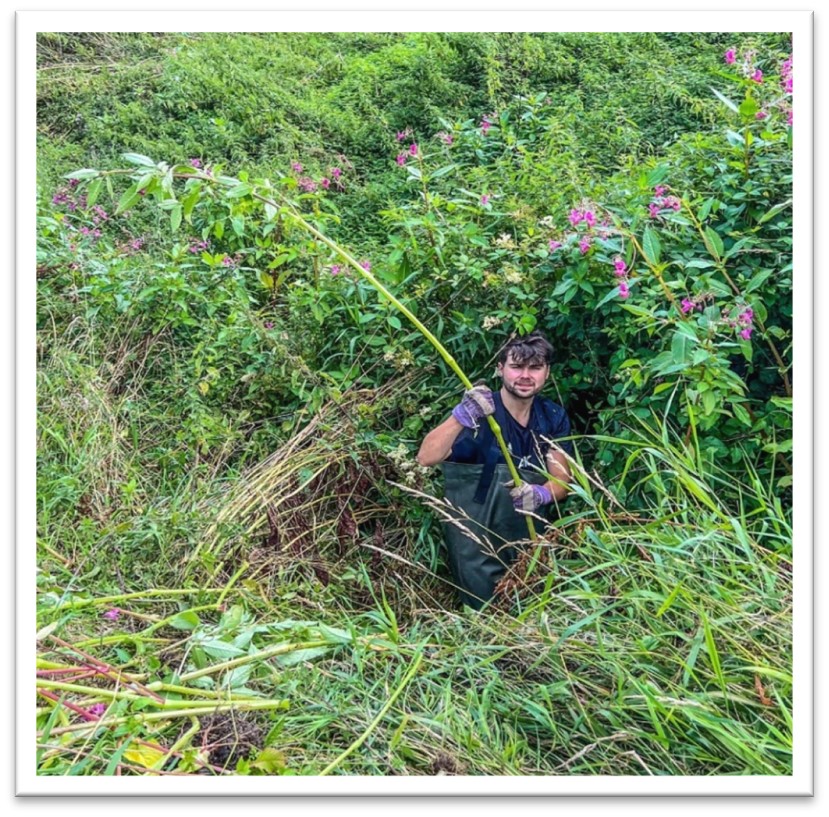
Figure 14: A picture of me, down and dirty, wearing borrowed waders, balsam picking with the Society! Summer 2023. (Accessed via the Society’s Facebook page.)
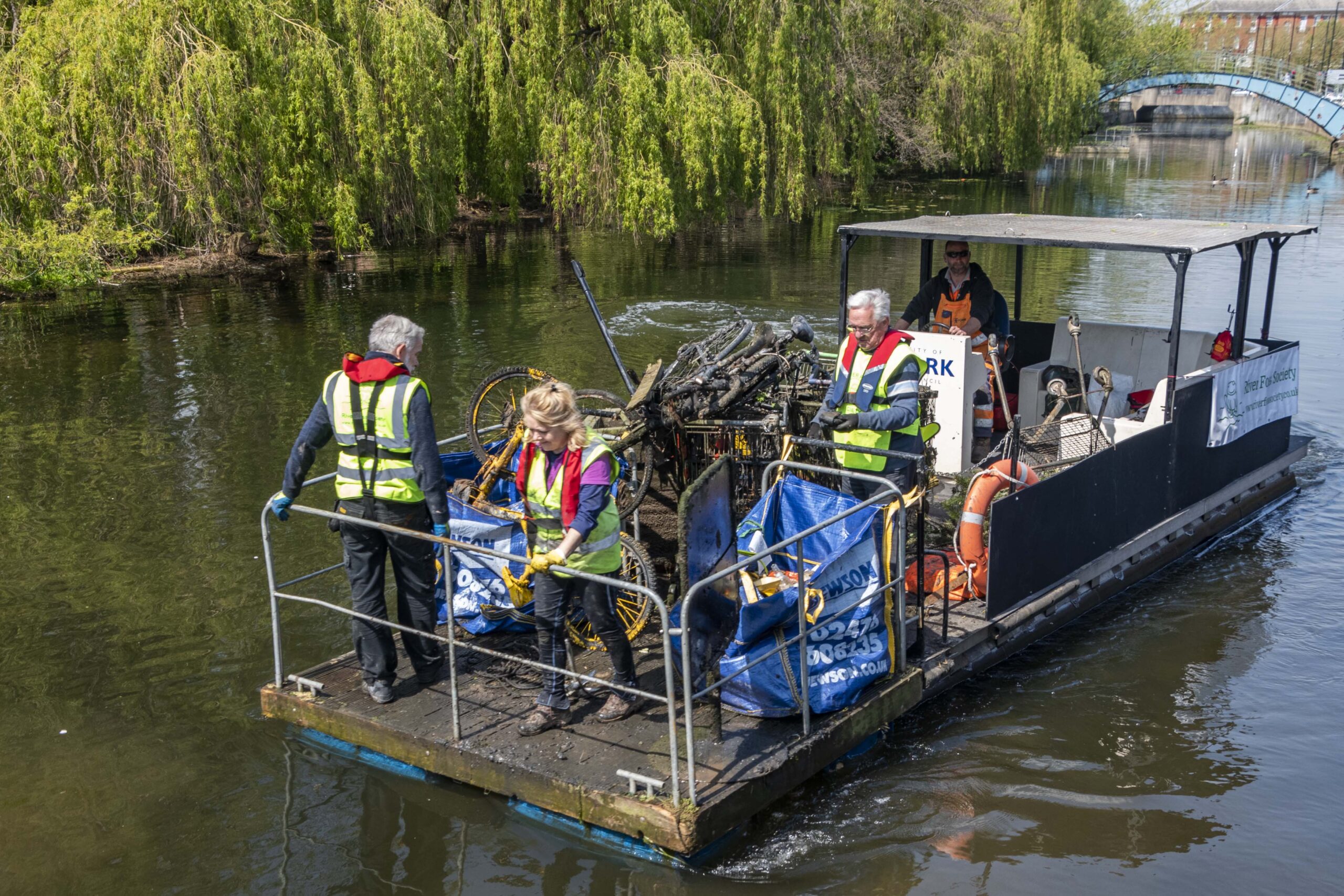
Figure 15: Litter-picking volunteers on the Council barge, Foxy, summer 2023. (RFS archives).
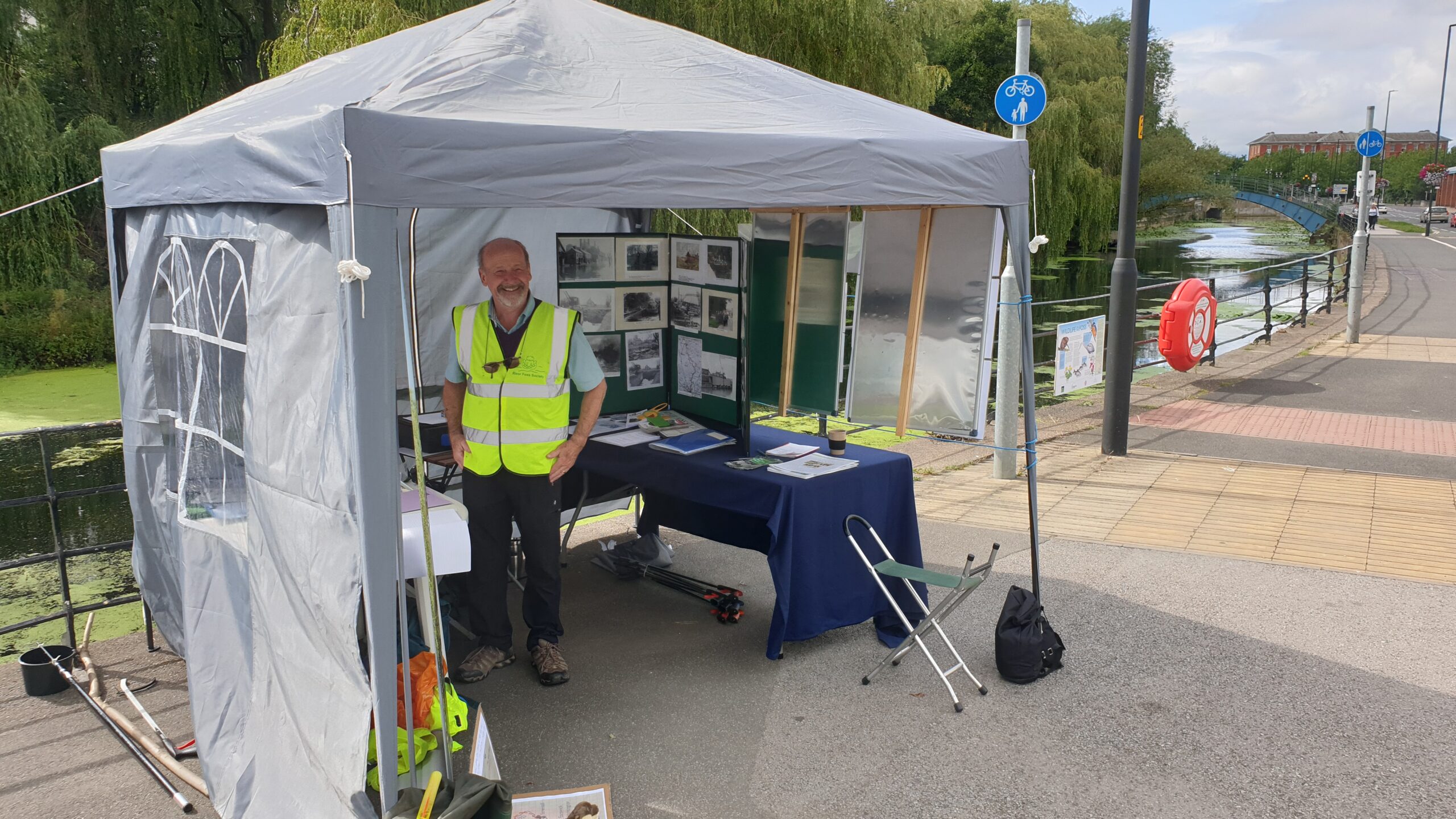
Figure 16: Mike Gray manning the fort at York Walls Festival – an example of the Society’s stalls, (RFS archives).
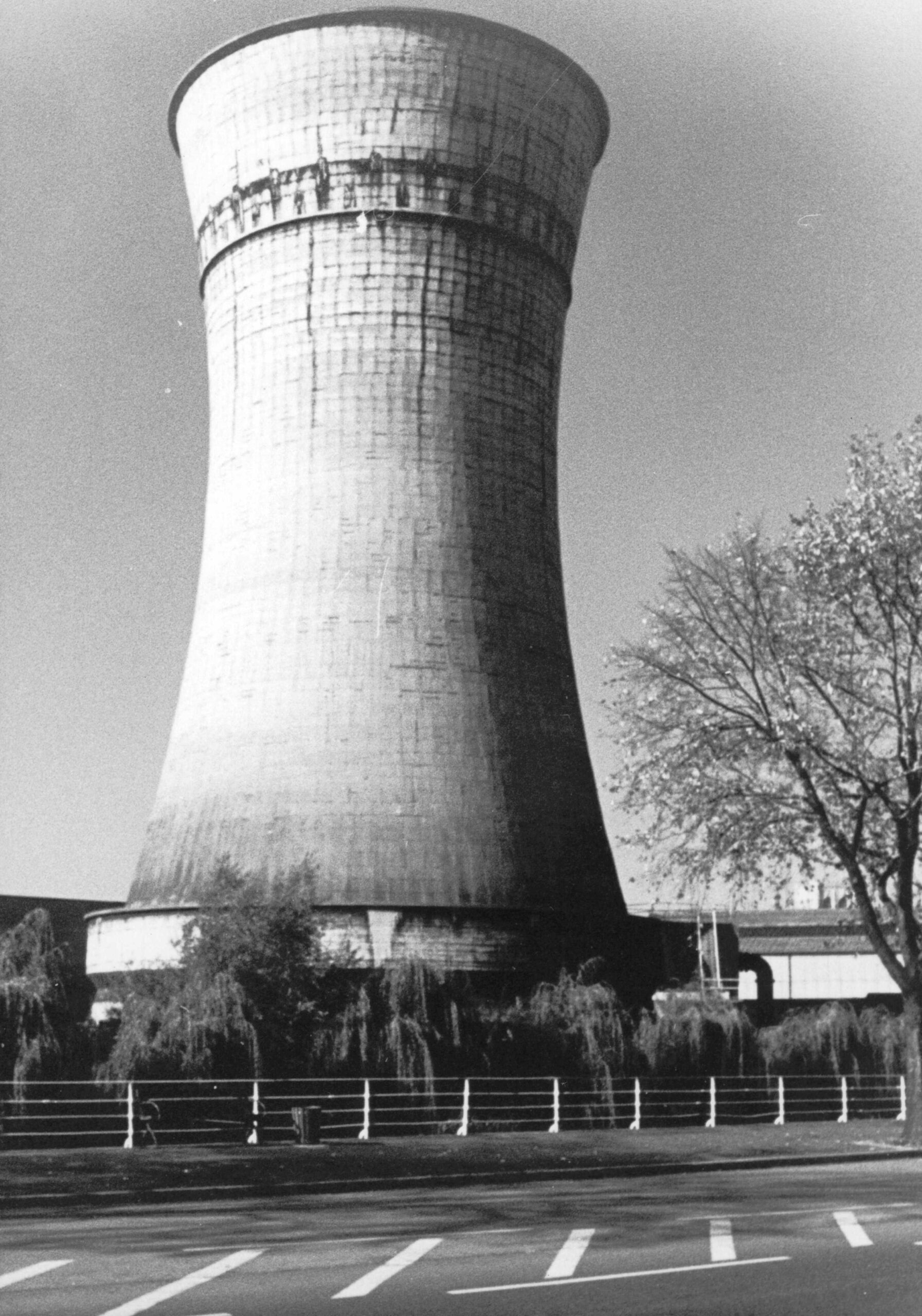
Figure 17: The cooling tower at the former Foss Island power Station. The nature reserve now exists on this site. (unknown source)
Riverside Developments
In the course of fifty years the River Foss has witnessed a great number of changes along its banks, from declining industries and the demolishing of industrial relics to the erection of new housing developments. The 2000s presented a unique set of challenges for the Society to battle and overcome in order to protect the Foss. The river has experienced several developments in this period, including the Hungate Development which was passed by the City of York Council at a planning meeting on 22 February 2007. Since this Development was first announced around the turn of the century the Society has discussed several methods of ensuring the safety of the natural environment surrounding the Foss, and the interest in the river’s safety has been shared by the York Natural Environment Trust with whom the Society worked closely. The Society committee were involved in discussions at the start of the Hungate housing project where they recommended the installation of bird boxes in the surrounding trees, and that a concrete wall be built with special slots for kingfishers to nest. The committee also convinced contractors to construct the concrete chambers underground to attract breeding otters, and the structures can still be found among the undergrowth.
In 2007 the Society would successfully object to the proposal of a touring caravan site on Landing Lane – a site of historical interest as, when the Foss was canalised, cargo boats were loaded and unloaded at this location. It was argued that the caravan site would be inappropriate in such a location for it would be detrimental to the Foss’s wildlife habitats while blemishing the natural beauty that many local residents from nearby communities benefit from enjoying. City of York Council agreed with the Society’s objections, and such was the end of the proposal.
On other occasions the Society felt it unnecessary to intervene – such as the Fishergate Centre by Castle Mills Lock transforming into a hostel for the homeless. The Society considered the development harmless to local wildlife, and so made no objection.
The Society’s newsletter
The newsletter probably started in 1973 soon after the society was founded, though the first issue in the archives is one from 1977, when it was a two sided typed document, possibly printed off by Sessions, and was headed by the frog logo. That issue featured an editorial about the cooling tower on Foss Islands Road becoming redundant, and asked what was to become of the site. The editor’s name is not on the sheet and remains unknown. The RFAS, as it was then, was talking to the City of York Council (CYC) about being involved in the future of the site once the tower had been demolished. The creation of a nature reserve in that area is a topic which continued to be written about in newsletters for many years, the society’s efforts being led by Ralph Fearnehough.
There is at least one copy of almost all the newsletters from February 1989 onwards in the York Explore Archives – file RFS/7. September 1993 was the last in which the word Amenity appeared in the title. During this time, it remained a 2-4 page typed letter.
Topics of interest were: the society’s walks, otters (rarely, if ever, seen), birds (an annual survey was carried out along the river for many years), litter (Foxy was used, as she is now, and was reported to have worked up as far as Bell Farm). All these issues, with the exception of birds, are still live today. In the 2003 spring issue, Bill Sessions wrote an article to commemorate the 30th anniversary of the society.
The newsletter continued in much the same format, with occasional minor modifications, until 2006 when Amanda Watterson took over. The autumn issue in 2007 was the first to appear in colour, and in an all-new format. It has continued to the present day in much the same guise, varying from 2-4 pages, and with 3 or 4 issues per year. Minor changes were made in 2011 and the frog changed his shape and background in 2016. The header colour was changed to gold for 2023 as part of the society’s 50th anniversary celebration.
Beth Shurter took over the reins in mid-2010, initially continuing to produce three issues a year – due to lack of activities in winter – but in 2014, with the widening of the society’s environmental interests, a winter issue was added. The average size of the newsletter increased too, with one of 4 pages and the rest of 6 pages. In 2023, to cover all the extra activities for the 50th anniversary, it was expanded to an 8 page issue.
In line with the times, nearly 40 percent of its readers chose to receive the newsletter by email .
If anyone has any old copies of the newsletter that they would either be prepared to donate to the society, or allow us to copy, and add to the archive at York Explore it would be really appreciated.
Operating Castle Mills Lock
As many Foss enthusiasts will already know, our beloved river served a brief tenure as a canal, with the Foss Navigation Company obtaining a government charter to canalise the Foss in 1796, making the river navigable for almost twelve miles to Strensall and onwards by a cut (no longer visible) to Sheriff Hutton before ceasing short of Sheriff Hutton Bridge. I strongly recommend Michael Fife’s work in The River Foss for a complete history of the Navigation Company up to 1973. In 1852 the Company was sold to York Corporation, and by 1859 all locks but one – Castle Mills Lock – had been closed; the canal was never truly commercially viable, and the Foss was among the earliest canals to be displaced by railways as the preferred method of transporting goods. The lock at Castle Mills, however, outlived the other five locks, and supplies were transported to Rowntree’s Wharf by Wormald’s Cut until the 1980s, and barges would bring two hundred tonnes of newsprint per week from Goole through Castle Mills Lock until 1997. The existing lock was built by York Corporation in 1889 for flour millers Henry Leetham & Sons to transport their produce. Indeed, boating activity has been sparse in recent years since commercial activity has ceased entirely, but volunteers from the North Riding Branch of the Inland Waterways Association (a branch that exists now only for lock operations) and the River Foss Society make it possible for pleasure craft to access approximately one mile of navigable Foss by operating the last remaining lock at Castle Mills. The Inland Waterways Association (IWA) successfully campaigned for permission to operate the lock in 2004, meaning that suitably trained volunteers may operate Castle Mills Lock when required. It was realised, however, that permission to operate the lock was a matter of verbal agreement only, and it was appreciated that – as part of risk assessment – there would be immense difficulty for all parties involved should there be an accident on the river. A “Memorandum of Understanding” was therefore agreed in 2020 between the IWA and City of York Council – the Council being the navigation authority responsible for the lower Foss – so that volunteers from the River Foss Society and IWA can be trained by City of York Council Officer Brian Hebditch to operate Castle Mills Lock and provide access to the Foss. The Society was (is) accepted as an interested party in the Memorandum of Understanding, and while, strictly speaking, anyone can be trained to operate the lock, it is understood that training is generally reserved for members of the IWA, the Society, or persons with prior experience and interest.
Accessing the Foss up to Wormald’s Cut has since been added to the IWA’s Silver Propeller Challenge to encourage determined waterway users to access more remote parts of the waterway system. Ripon Canal Head and the Melbourne Arm on the Pocklington Canal are other local challenges. There have been several difficulties training voluntary lockkeepers in recent years as practical experience has been lacking due to Covid restrictions (2020), Council work on Blue Bridge (2021), the Environment Agency’s work on the Foss Barrier (2021) and very low water levels (2022/3). This has led to many volunteers requiring retraining, but operating the lock continues to be a small but significant part of the Society’s activities.
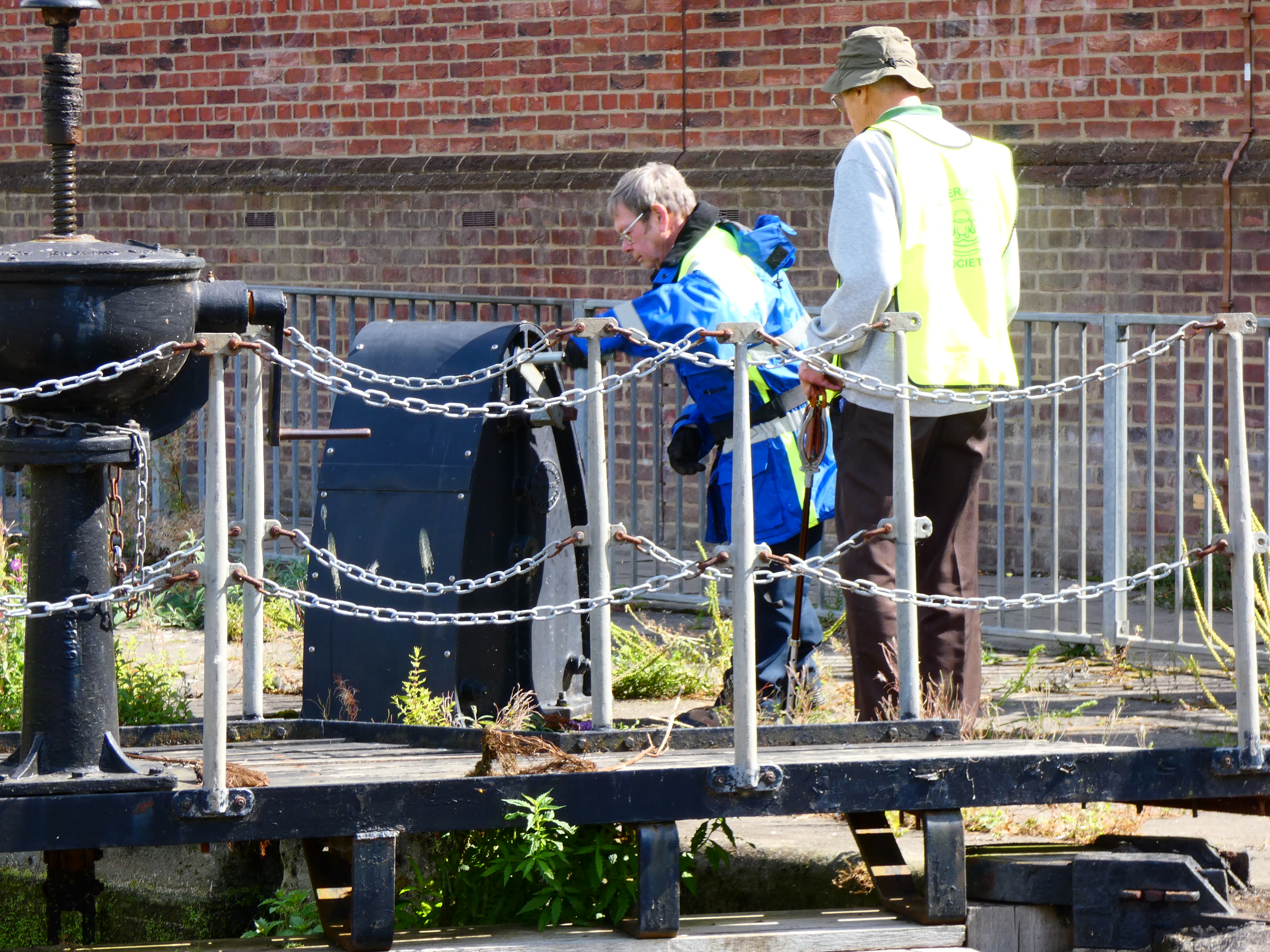
Figure 18: Peter Hopwood and Neil Ogley operating the lock for the passage of Slipstream August 2021 (RFS archives)
Water level has also proven to be an issue for passage through the lock, with too much rain causing flooding and too little rain rendering the lock unusable. It was for this reason that, in the summer of 2018, access through the lock was begrudgingly denied to the narrowboat Water Routes because of low water levels. This was particularly disappointing as Water Routes records its adventures to produce DVDs and maps which could be useful publicity for a system that has often been overlooked. Fortunately, Water Routes made a return on 6th July 2022 and was granted passage through the lock at last, and volunteer lockkeepers Neil Ogley, Tim Rane and Michael Alexander were on hand at short notice to operate Castle Mills Lock. For their efforts, they were rewarded with a trip on the boat. Water Routes made it as far as Huntington Road (where a fallen tree underwater blocked further progress) before employing the bow thruster to reverse back to Wormald’s Cut where it could finally turn around, stating: “Fortunately we had a bow thruster to steer with – I wouldn’t have attempted it without one..”
It is therefore recommended that larger craft do not pass beyond Wormald’s Cut as it is not possible to turn around. It is also worth noting that passage up the Foss is limited to a two-hour window and there is no overnight mooring. If the reader of this wishes to take on the Foss themselves, passage through Castle Mills Lock can be granted by contacting the IWA with at least two days’ notice (or preferably as much notice as possible) by emailing castle.mills@waterways.org.uk. Additionally, if one wishes to become a voluntary lockkeeper, one can find out more information via the same email address. Tim Rane currently serves the Society as head of Castle Mills Lock Operation.
Final Notes
It is my hope that the readers of this work will feel a greater sense of connection to the River Foss Society and will wish to become a part of its history. After all, history connects us, and perhaps this work will inspire readers to make their own contributions to the history of the Foss. The history of the River Foss Society is a fascinating one, complete with ups, downs, struggles and triumphs, and it is remarkable how much one small Society can accomplish in half a century. With dedication, resilience and genuine determination, the Society have:
– Opened up rights of way along the river and regularly walk them,
– Supported the planned reinstatement of a footbridge,
– Held regular litter picks and weed control sessions,
– Promoted significant improvements in water quality,
– Established nature reserves by the river,
– Raised awareness of the Foss by talks, exhibitions and leaflets and interpretation panels,
– Played an active role in monitoring development and planning applications along the river,
– Organised visits.
Of course, if one wishes to research the history of the River Foss Society even further, there are several items available to view in the York Archive, and the River Foss Society handbook which, available to members, contains information about the Society’s current activities and details the Society’s conservation efforts in greater detail. Further information about the Society can be found online at Facebook, Twitter and the Society’s website, or in newsletters. Also on the Society’s website is information on how to join the Society and the perks of doing so – one of which is becoming a part of this Society’s captivating story.
Acknowledgements
I would like to thank many individuals for their contributions to the History of the River Foss Society. I would first like to thank former treasurer / membership Secretary Peter Hopwood, former Secretary June Card, and former Chairman and current vice-Chairman John Millett, who have been kind enough to discuss with me their time in the Society and provide me with vital intel to fill in gaps left by source material. I would also like to thank Mark Sessions for his emails where he has been kind enough to answer questions about his father, and for scanning documents and photos.
I would then like to thank Peter Freer for – after I announced myself unexpectedly at his door – sending me documents belonging to his father, Geoffrey Freer, who was on the Huntington Parish Council for several years before passing away aged 90 in January of this year. After talking history with Peter, he informed me that his father was a passionate local history enthusiast and I am disappointed I did not get to meet him, but I would like it to be known that he has helped in this project by keeping his own private collection. I would also like him to know that enthusiasm for local history lives on and that there are young persons – such as myself – who enjoy keeping the past alive. I would like to express a thank you to Bill Sessions for creating the Society and for his commitment to the Foss for many years, and I only wish I could have met him and had his direct influence in writing this history. I would like him to know that the Society still follows in his footsteps and works hard to fulfil his ambitions. I also understand there will be many dedicated members of the Society who will have played a significant role in the Society’s history but may not be mentioned by name, so I would also like to thank all committed members – past and present – for their role in shaping the Society throughout the years. Expert genealogist and friend Chris Broom is also deserving of a mention for his shared enjoyment of local history. His inputs in our conversations are always valued, often hilarious, and I always enjoy speaking with him.
I would especially like to say thank you to my dad (John Tod) for often talking history with me, and to my mum (Kay Johnson-Jones) for also listening to my ramblings about obscure local history while contributing greatly to this project with her invaluable proofreading. Both never fail to provide endless support. I would finally like to express gratitude to Mike Gray of the Society for first setting me up with the project and putting his faith in this history student to write it. Mike was my first introduction to the Society and reassured me of his confidence that I could research and write this history before then sending me many sources that have made this project doable. Mike is a committed member of the Society, the Society’s dedicated events manager, and a very kind man. I have greatly enjoyed working with archive material, forgotten documents, testimonies of past and present, and writing and researching this fascinating history.
